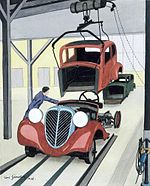Carl Grossberg
Carl Grossberg (born September 6, 1894 in Elberfeld , † October 19, 1940 in Laon ; actually Georg Carl Wilhelm Grandmontagne ) was a German painter. In static, cool oil paintings and watercolors, he designed cityscapes, industrial and technical representations. With a noticeable turn to New Objectivity , factory halls and machine portraits served as central motifs.
Life
After primary school, Grossberg attended the secondary school in Lennep and, from 1909, the grammar school in Elberfeld . From 1913 he studied architecture in Aachen, but moved to Darmstadt a year later. During the same period, his father left Grandmontagne, to the regret of his son, whose name was Germanized. In 1915 Grossberg was called up for military service, fought - according to his own report - as an officer at the front, was wounded and returned to his homeland in 1918. At the beginning of 1919 he continued his studies; initially as a student of Walther Klemm at the University of Fine Arts in Weimar, then from mid-1919 to 1921 as a student of Lyonel Feininger at the Bauhaus. There he occupied himself with painting, decorative art and spatial art, before moving to Würzburg in 1921 to study. Shortly afterwards he met Tilde Schwarz, whom he married in 1923. The marriage resulted in two daughters, one of whom was the future painter and designer Eva Grossberg . In 1926 Grossberg had his first solo exhibition at the Kunsthaus Schaller in Stuttgart, which made him famous. Another was to be seen in the Nierendorf Gallery in Berlin.
Several stays in Cologne, Düsseldorf and Berlin followed from 1927. Finally, in 1929 he took part in the exhibition “ New Objectivity ” at the Stedelijk Museum in Amsterdam, and two years later he was awarded the Rome Prize. From 1933 Grossberg worked on the implementation of his “Industrial Plan”, a cycle of pictures that was to represent a cross-section of the most important industries in Germany. The project remained unrealized. A year later, Grossberg accepted the order for a monumental wall painting (45 × 12 meters) for the exhibition "German People - German Work". In the same year a Grossberg exhibition was realized in the Kestner Society in Hanover, a retrospective in the Folkwang Museum in Essen followed in 1935. On August 25, 1939, Grossberg received the position order and was deployed as an occupation officer in Poland. While on vacation at home, he was killed in a car accident in the Compiègne forest .
plant
In Grossberg's pictorial work at the beginning of the 1920s, cityscapes still predominate, for whose artistic expression Lyonel Feininger is likely to have been innervating ( Houses, Tower and Mountains 1919/20, Small Houses 1923). The building block-like structures are shown in bright, iridescent colors and show little interest in the wealth of precision and detail that will be characteristic of the later Grossberg. From the mid-1920s onwards, Grossberg intensified the presentation of technical equipment, the design aspect of which increasingly came under an engineering perspective. Now his so-called “dream pictures” are being created, in which he enriches geometrical machine parks with surrealistic elements and expands them into a symbolically superimposed art space ( dream picture rotor 1927, steam boiler with bat 1928). Bats, monkeys and birds populate Grossberg's purist industrial buildings and are reminiscent of a re-colonization of modernity through pre-social forms of life ( Renaissance 1929). It was only at the beginning of the 1930s that Grossberg abandoned his “dream images”. Technological interiors dominate, free of any annoying accessories. Oversized boilers with scaffolding and pipe systems surrounding them at right angles are now just as image-defining motifs ( The yellow boiler 1933; oil refinery 1933), as are drive or flywheel constructions ( flywheel with drive belt 1934). Grossberg's architectural ethos always accompanies his diction and transfers industrial functionaries into isolated, artificial monuments. Removed from organic-human commitment, rooms are spanned and arranged according to merely mechanical aspects. This is where the distant, undercooled imagery unfolds, that timeless sterility that ultimately vouches for Carl Grossberg's originality and establishes his fame as an industrial painter and as a modernist .
Exhibitions (selection)
- 2014: Carl Grossberg , Galleria Milano, Milan
- 2012: Grossberg , Galerie Michael Hasenclever, Munich
- 2006: Carl Grossberg , Galerie Michael Hasenclever, Munich
- 2003: Carl Grossberg , Galerie Michael Hasenclever, Munich
- 1999: Carl Grossberg - Painter and Draftsman of the New Objectivity 1894–1940 , Galerie Michael Hasenclever, Munich
- 1994/1995 : Carl Grossberg. Retrospective for the 100th birthday , Von der Heydt-Museum, Wuppertal, in the Kunsthalle Tübingen , Kunsthalle zu Kiel, in the Sinclair-Haus, Bad Homburg
literature
- Sabine Fehlemann (Ed.): Carl Grossberg. Retrospective for the 100th birthday , catalog for the exhibition in the Von der Heydt Museum, Wuppertal, in the Kunsthalle Tübingen , Kunsthalle zu Kiel, in the Sinclair-Haus, Bad Homburg 1994/1995, Cologne 1994
- Michael Hasenclever (Ed.): Carl Grossberg. Images of architecture and industry in the twenties and thirties. Exhibition catalog , Munich 2006
Web links
- Literature by and about Carl Grossberg in the catalog of the German National Library
| personal data | |
|---|---|
| SURNAME | Grossberg, Carl |
| ALTERNATIVE NAMES | Grandmontagne, Georg Carl Wilhelm (real name) |
| BRIEF DESCRIPTION | German painter |
| DATE OF BIRTH | September 6, 1894 |
| PLACE OF BIRTH | Elberfeld |
| DATE OF DEATH | October 19, 1940 |
| Place of death | Laon |






